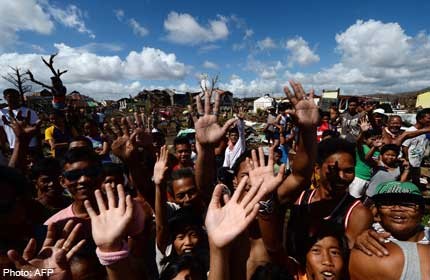Aid pushes through to Philippine typhoon survivors

GIPORLOS, Philippines - The first food and medical aid began reaching isolated towns Saturday devastated by the typhoon that killed thousands in the Philippines, as humanitarian groups warned of huge challenges in accessing hundreds of small island communities.
The unprecedented ferocity of Super Typhoon Haiyan on November 8 and the scale of destruction it caused completely overwhelmed the initial relief effort, leaving millions in the worst-hit central islands of Leyte and Samar hurt, homeless and hungry, with no power or water.
Eight days later, a working aid pipeline was in place on the ground, funnelling emergency supplies to those left destitute in the ruins of Leyte's Tacloban city, while helicopters flying off the aircraft carrier USS George Washington brought some relief to outlying areas.
In Giporlos, a small coastal town of around 12,000 people in eastern Samar where the typhoon first struck, a US Seahawk helicopter flew in the first relief supplies Saturday, landing in the playground of a ruined elementary school.
"We're very happy even if it isn't really sufficient for us," said resident Maria Elvie Depelco.
"We accept a little, and we survive. Because there's no more food, no houses here," she said, pointing to the flattened remains of the town where 12 people died.
In the nearby town of Guiuan, planes laden with supplies were landing and taking off every few minutes from an old military airstrip that had been reopened.
The Red Cross and Medecins Sans Frontieres (Doctors Without Borders) said they would have mobile surgical units up and running in Tacloban by the end of the weekend.
"The place really needs to be saturated with relief," Red Cross Asia-Pacific spokesman Patrick Fuller said in Tacloban.
"People literally have nothing. Money is useless here."
Since the arrival of the USS George Washington late Thursday, the US military said it had delivered 118 tonnes of food, water and shelter items to Tacloban and elsewhere, and airlifted nearly 2,900 people to safety.
Japan confirmed it would send almost 1,200 troops to join relief efforts along with three warships, 10 planes and six helicopters - its military's single largest aid deployment.
"We don't know how we'll start again," said Benny Creer, 53, as he helped a relative sweep debris from his shattered home in Tacloban.
"In this situation, there are no poor, no rich - everyone is equal," Creer said.
The National Disaster Risk Reduction and Management Council on Saturday put the official death toll at 3,633, many of them killed by five-metre (17-feet) storm surges that hit Tacloban.
Another 1,179 people were listed as missing and nearly 12,500 injured, and the death toll was widely expected to continue climbing as more complete assessments were made.
The UN reported that 4,460 had been confirmed dead, and said Saturday that 2.5 million people still "urgently" required food assistance.
An estimated 13 million people were affected by the storm, which swept off the Pacific Ocean with some of the strongest winds ever recorded, including nearly 1.9 million displaced survivors.
Fears for remote communities
The World Health Organisation voiced concern over the welfare of remote communities on smaller islands, which posed an "exceedingly complicated" aid challenge.
"It is essentially like mounting at least seven separate, simultaneous relief efforts," said Julie Hall, the WHO's representative in the Philippines.
Frustrated with the slow pace of the initial relief effort, a large number of people with relatives in the impacted areas decided to take matters into their own hands.
Filling boxes and sacks with everything from packets of rice to cup noodles and candles, they boarded ferries from Cebu island to Ormoc town on Leyte.
"That's my village," Nick Cantuja sobbed, pointing from the ferry as it approached the coast.
"Our house is gone now," she said. "Everything... it's gone.
"Yesterday, a Red Cross team was able to reach there but it's not enough," she added.
Despite the fears for those living in remote areas, some appeared to have been better prepared for the typhoon than those in larger towns and cities.
The tiny Camotes islands, between Cebu and Leyte, took a direct hit that flattened most villages, but out of a population of 89,400 there were only five confirmed fatalities.
Alfredo Arquillano, the former mayor of the islands' largest town, San Francisco, said Camotes' residents had been practising typhoon drills for years. "We knew we were vulnerable, so we made absolutely sure that everybody knew what to do and where to go," Arquillano told AFP by phone.
All 1,000 residents of one of the chain's tiniest islets, Tulang Diyot, were evacuated to a larger island before Haiyan made landfall.
"My goodness, it was a good decision. It's fair to say it saved everyone's life. There is not one house left standing on Tulang Diyot. Everything was wiped out," Arquillano said.